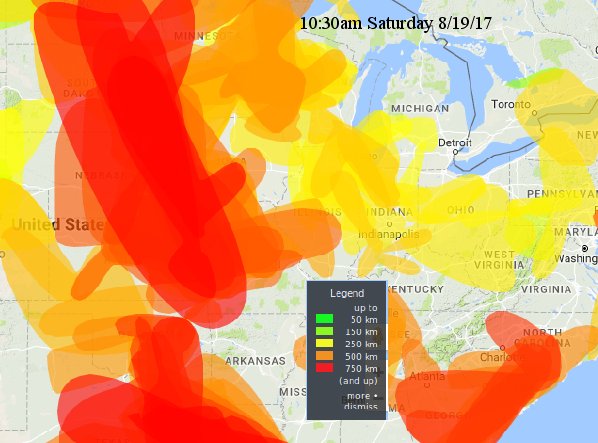Dave N0MUA in Coffeyville Kansas said hello to Norm WA0JYD and Tom K0TIK on 146.94 Saturday 8/19/17 at 10:30am. Dave was keying up the Aksarben repeater in Omaha, and the Grand Island repeater along with a number of other repeaters he mentioned. Traffic on 146.52 simplex offered up a number of long distance VHF contacts.
Point of Interest: Grand Island Nebraska also has a repeater on 146.94. At 10:00am Sat 8/19 morning a ham radio Net on the Grand Island repeater could be heard clearly by listeners in Omaha. Attempting to check in from Omaha resulted in keying up both repeaters, and Aksarben winning FM capture for the Omaha operator.
While Norm was trying to clarify the dates of a flea market with Tom, there were a handful of distant operators jumping in to say hello from locations well outside 94’s coverage area.

Another round of Tropospheric Ducting has made VHF ham radio very interesting during the late summer (August 2017,) and quite confusing for those not knowing what’s going on.
- See our July 24, 2017 story, “Tropospheric Ducting“
There’s normally a number of these events during the summer months. In 2016 one ham and SWIARC member made a regular practice of checking into various VHF nets around Iowa, Kansas, and Nebraska during the summer months. Last July there occurred a series of four weekends in a row that consistent contacts could be made at 100mi or better. Although we’ve had some interesting VHF band openings this summer (2017) the occurrences seem fewer than last. It’s possible that the action will pick up during the months of August and early September. Listen on 146.52 simplex, the VHF calling frequency, and you might be pleasantly surprised at who you’ll hear.
The Noon Swap Net on 146.82 should be interesting today!
Tropospheric Ducting
Typical conditions required for a good duct to occur are:
- An increase in temperature by 3 degrees or more per 100ft.
- A rapid decrease of RH (dew-point) with height.
Typical weather conditions which can be favourable for ducting are:
- Warm dry air over a cooler surface, especially a large body of water
- Surface cooling under clear skies overland
- Anticyclone (high pressure) or developing high pressure ridges with a cold surface
- At fronts with a strong thermal contrast
- In cold downdrafts associated with cumulonimbus clouds (indicated by heavy showers or thunderstorms)
This story was originally titled “Saturday VHF Explosion” published Saturday, August 19, 2017.